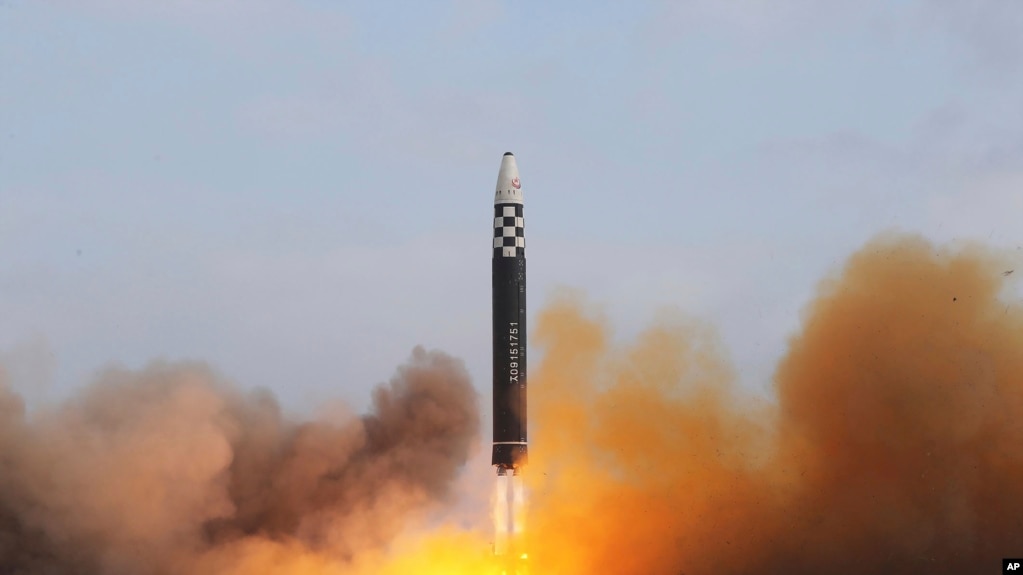Reasoning With North Korea
"Based on calculations taking the trajectory into account, the ballistic missile this time around could have had a range capability of 15,000km, depending on the weight of its warhead, and if that's the case, it means the US mainland was within its range.""We have told [Pyongyang] that we absolutely cannot tolerate such actions."Japan's defence minister Yasukazu Hamada"Even if the North does successfully launch the Hwasong-17, the threat will not have significantly increased.""It must prove it has mastered the technology to be able to mount enough small nuclear warheads onto the ICBM."Yang Uk, military expert, Asan Institute."[Threats from the United States and its allies provoked our country to] substantially accelerate the bolstering of its overwhelming nuclear deterrence.""Our party and government will resolutely react to nukes with nuclear weapons and to total confrontation with all-out confrontation."North Korean leader Kim Jong Un
 |
| Pyongyang is developing a new type of long-range missile EPA |
The most recent launch of an ICBM from North Korea's capital region was detected by South Korea's Joint Chiefs of Staff in its second major weapons test conducted this month. One that indicated a potential capacity to launch nuclear strikes, possibly on the entire U.S. mainland. North Korea is notoriously secretive about its Intercontinental Cruise Ballistic Missile program, just as it is about its nuclear program to match the ICBMs. Its occasional testy and celebrated tests alert the world to its covert activities.
And while Pyongyang is deliberate about its secret plans, it is also deliberate about flaunting its technical progress. Experts remain uncertain whether the country's production includes functioning nuclear-armed missiles, leading some to hazard that Friday's launch while involving its longest-range missile yet under development, designed to carry multiple nuclear warheads as quite ready to challenge what it insists is the United States' plan to attack North Korea. Nor that its latest ICBM design has the capability of overcoming U.S. missile defence systems.
Its intention of challenging the United States and threats it has the capability of hitting the mainland anywhere along its extensive coast, is without question. Despite its belligerence and the danger inherent in its surprise missile tests unsettling its neighbours, China and Russia continue to block any U.S. moves to strengthen UN sanctions purposing to curb North Korea's nuclear program.
Predictably under the circumstances, the U.S. responded by condemning the launch, promising to take "all necessary measures" for the safety of its territory and that of its allies South Korea and Japan. "We again call for North Korea to stop further unlawful, destabilizing acts. On behalf of the United States, I reaffirm our ironclad commitment to our Indo-Pacific alliances. Together the countries represented here will continue to urge North Korea to commit to serious and sustained diplomacy", stated Kamela Harris, at a regional forum in Bangkok.
A futile promise, since North Korea is not and never has been amenable to reason. It is congenitally, chronically paranoid and the assurances the U.S. gives to its allies only provokes further reaction from Pyongyang. When Donald Trump was president, he made the surprise move of meeting directly with Kim Jong Un, who loved the attention, and played his role alongside that of Mr. Trump, but the war games shared with South Korea in U.S. exercises were and are guaranteed to arouse rage and threats from the North.
 |
| The North Korean government shows the test-firing of a missile at Pyongyang International Airport in Pyongyang, North Korea, Nov. 18, 2022. Photo released Nov. 19, 2022. |
Japanese and South Korea estimated the missile flew 1,000 kilometres with a maximum altitude of 6,000 to 6,100 km. According to Japanese Defence Minister Yasukazu Hamada, depending on the weight of a potential warhead, the missile had a range in excess of 15,000 km -- "In which case it could cover the entire mainland United States". North Korea, believes Kwon Yong Soo, former professor at Korea National Defence University, tested a developmental Hwasong-17 missile which has the capacity to carry three to five nuclear warheads, flying as far as 15,000 km.
A long-range missile like the Hwasong-17, capable of flying a lengthier route to the American mainland to evade the current U.S. missile defence systems is what North Korea needs for the purpose, emphasized Professor Kwon. North Kora has demonstrated its missiles have ICBM-class flight ranges but has not yet proven warheads could survive the harsh conditions of atmospheric re-entry, pointed out missile expert Chang Young-keun at Korea Aerospace University.
Friday's launch, explained Professor Chang, was successful; flight details indicating it was the same type missile North Korea tested in March when it claimed to have launched a Hwasong-17. "Pyongyang must immediately cease its destabilizing actions and instead choose diplomatic engagement; [the launch] needlessly raises tensions", stated U.S. National Security Council spokesperson Adrienne Watson. To a country and a leader that is tone-deaf to what the international community expects it 'should' do.
 |
| North Korean leader Kim Jong Un, left, and his daughter inspect what it says a Hwasong-17 intercontinental ballistic missile at Pyongyang International Airport in Pyongyang, North Korea, Nov. 18, 2022. Photo provided by the North Korean government |
Labels: China, ICBMS, Japan, North Korea, South Korea, Threats, United States
0 Comments:
Post a Comment
<< Home